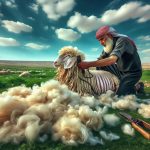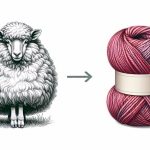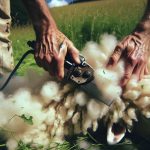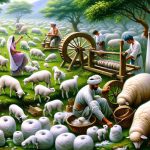Are you curious about whether wool is a natural fabric? Look no further, as this article will provide you with all the information you need.
We will delve into the origins of wool, the production process, and the properties that make it unique. Discover the benefits of using wool, its environmental impact, and how to properly care for wool fabrics.
Get ready to unravel the truth about wool and learn why it is a popular choice in the textile industry.
Table of Contents
The Origins of Wool
Wool is derived from the hair of animals, such as sheep, goats, and alpacas. It is a natural fabric that has been used for centuries due to its unique properties.
Wool farming involves raising these animals and shearing them to obtain their hair. The process of wool processing begins with sorting the fleece by color and quality. Then, the fleece is washed to remove dirt, grease, and other impurities.
After washing, the wool is carded to align the fibers in preparation for spinning. Spinning is the process of twisting the fibers together to create yarn. Once the yarn is ready, it can be woven or knitted into various fabrics.
Wool has several benefits, including its natural insulation properties, moisture-wicking abilities, and flame resistance. It is also durable and can be easily dyed in a wide range of colors.
Wool farming and processing are important industries that provide employment opportunities and contribute to the production of high-quality wool products.
Wool Production Process
In this discussion, you will explore the key points of sustainable wool production and the ethical treatment of sheep.
Sustainable wool production focuses on minimizing the environmental impact of the entire wool production process, from sheep rearing to the final product. This includes practices such as responsible land management, careful use of resources, and ethical treatment of animals, ensuring the well-being of the sheep throughout their lives.
Sustainable Wool Production
If you want to support sustainable practices, you should look for brands that prioritize ethical wool production. Sustainable farming practices and animal welfare are key aspects of sustainable wool production. By choosing brands that prioritize these practices, you are contributing to the well-being of animals and the environment. Ethical wool production involves ensuring that sheep are raised in humane conditions, with access to clean water, proper nutrition, and adequate shelter. It also means promoting sustainable farming practices that minimize negative impacts on the environment, such as using organic fertilizers and practicing rotational grazing.
To help you make an informed choice, here is a table showcasing some criteria to consider when looking for brands that prioritize ethical wool production:
| Criteria | Description | Example Brand |
|---|---|---|
| Animal Welfare | Ensuring sheep are raised in humane conditions, with access to clean water, nutrition, and shelter | ABC Wool Co. |
| Sustainable Farming | Promoting sustainable farming practices that minimize negative impacts on the environment | XYZ Sustainable Wool |
| Transparency | Providing transparent information about their wool production process | DEF Ethical Wool |
| Certifications/Standards | Adhering to recognized certifications or standards for ethical wool production | GHI Eco-friendly Wool |
Ethical Treatment of Sheep
Sheep deserve to be treated ethically, ensuring they have access to clean water, proper nutrition, and adequate shelter. Sheep welfare and animal rights are crucial aspects of sheep farming. To ensure the well-being of sheep, farmers need to prioritize their health and comfort.
This includes providing them with clean drinking water, which is essential for their hydration and overall health. Proper nutrition is also important, as sheep require a balanced diet to thrive. This includes a variety of grasses, grains, and supplements to meet their nutritional needs.
Additionally, sheep should have access to adequate shelter to protect them from extreme weather conditions such as heat, cold, and rain. By prioritizing sheep welfare and animal rights, we can ensure that these animals are treated ethically and with the respect they deserve.
Properties of Wool
When it comes to the insulating properties of wool, you’ll find that it is hard to beat. Wool has a natural ability to trap air, creating a layer of insulation that keeps you warm in cold weather.
Additionally, wool is also known for its moisture-wicking capabilities. It can absorb and evaporate moisture, keeping you dry and comfortable.
Insulating Properties of Wool
Wool’s insulating properties make it a popular choice for cold weather clothing. Wool fibers have a crimped structure that creates air pockets, trapping heat and providing excellent insulation against the cold.
This natural breathability of wool allows moisture to escape, keeping you warm and dry. Additionally, wool is highly durable, making it ideal for garments that need to withstand frequent use and maintain their shape. Wool fibers have a natural elasticity that allows them to bounce back after being stretched or compressed, ensuring long-lasting performance.
Another remarkable quality of wool is its fire resistance. Unlike synthetic materials, wool is difficult to ignite and has a high resistance to flames. It also produces less smoke and does not melt or stick to the skin when exposed to fire. These properties make wool a safe choice for clothing and bedding.
Moisture-Wicking Capabilities of Wool
The moisture-wicking capabilities of wool are one of the reasons it is a popular choice for cold weather clothing. Wool has excellent breathability, allowing it to absorb and release moisture, keeping you dry and comfortable.
When you sweat, wool fibers can absorb up to 30% of their weight in moisture without feeling wet. This helps regulate your body temperature by allowing excess heat and moisture to escape, preventing overheating.
Wool also has natural odor resistance properties. It can effectively control odor-causing bacteria, keeping your clothing fresh even after prolonged use. These properties make wool ideal for outdoor activities and sports, where staying dry and odor-free is essential.
Benefits of Using Wool
Using wool in clothing provides numerous benefits. One of the main advantages is its ability to regulate body temperature. Wool has been a staple in fashion for centuries and continues to grow in popularity due to its unique properties and versatility.
Wool fashion trends have seen a resurgence in recent years, with designers incorporating this natural fabric into their collections. It offers a timeless and luxurious aesthetic that is hard to replicate with synthetic materials.
In addition to its aesthetic appeal, wool also offers environmental advantages. As a sustainable alternative to synthetic fabrics, wool is biodegradable and renewable. Unlike synthetic materials that contribute to plastic pollution, wool is a natural fiber that can be recycled and reused.
Furthermore, wool is a great insulator. It provides warmth in colder temperatures while also allowing the body to breathe in warmer climates. Its moisture-wicking properties help to keep you dry and comfortable, making it an ideal choice for outdoor activities or workouts.
Wool is also naturally flame-resistant and has natural UV protection, further enhancing its appeal as a fabric choice. With its numerous benefits and sustainable attributes, it’s no wonder that wool is a favorite among fashion enthusiasts and environmentally conscious individuals alike.
Environmental Impact of Wool
Now that you understand the benefits of using wool, let’s take a closer look at the environmental impact of this natural fabric.
Wool production can play a significant role in reducing carbon emissions and minimizing water usage.
-
Carbon Footprint: Wool is derived from sheep, which naturally absorb carbon dioxide from the atmosphere as they graze. This helps to offset the greenhouse gas emissions associated with wool production.
-
Sustainable Grazing: Sheep are often raised on land that is unsuitable for agricultural purposes, such as hilly or rocky terrain. They can graze on native grasses without the need for irrigation or synthetic fertilizers, reducing the environmental impact.
-
Water Conservation: Unlike other fabrics that require intensive irrigation, wool production requires significantly less water. Sheep obtain most of their water from rainfall, reducing the strain on water resources.
-
Biodegradability: Wool is a natural fiber that is biodegradable, meaning it breaks down naturally without releasing harmful pollutants into the environment. This makes wool a more sustainable choice compared to synthetic fibers.
-
Longevity: Wool garments are known for their durability and longevity. By choosing wool, you are investing in a fabric that will last longer, reducing the need for frequent replacements and ultimately reducing waste.
Considering the positive impact that wool production can have on reducing carbon emissions and minimizing water usage, it is clear that wool is an environmentally friendly choice.
Care and Maintenance of Wool Fabrics
Caring for and maintaining wool fabrics is essential to ensure their longevity and performance. Wool fabric care involves a few simple steps that can help you maintain the quality and appearance of your wool garments.
First and foremost, always check the care label on your wool items for specific instructions. Most wool fabrics can be hand washed or machine washed on a gentle cycle using cold water and a mild detergent. It is important to avoid using bleach or harsh chemicals as they can damage the fibers.
After washing, gently reshape the garment and lay it flat to dry. Avoid hanging wool garments as this can cause them to stretch out of shape. To remove any wrinkles, you can use a steam iron on a low setting or hang the garment in a steamy bathroom to allow the wrinkles to naturally release.
Regular brushing with a soft bristle brush can also help to remove any surface lint or hair. By following these simple care and maintenance tips, you can ensure that your wool fabrics remain in great condition for years to come.
Conclusion
In conclusion, wool is indeed a natural fabric that has been used for centuries. It is derived from the fleece of sheep and undergoes a production process that includes shearing, cleaning, and spinning.
Wool possesses several unique properties such as insulation, moisture-wicking, and flame resistance, making it an excellent choice for clothing and home textiles. Additionally, wool has a minimal environmental impact compared to synthetic materials.
By following proper care and maintenance techniques, wool fabrics can last for a long time, ensuring their durability and sustainability.
- Does Cotton Polyester Fabric Wrinkle? (And How to Fix It) - June 23, 2025
- Why Poly-Cotton Is the Go-To Fabric for T-Shirts and Hoodies - June 23, 2025
- 50/50 Cotton Polyester Blend vs. 100% Cotton: An Ultimate Showdown - June 23, 2025






